East
Penn Traction Club Meet
***
Each
May in odd years, the East Penn
Traction Club holds its main traction
meet. Operating traction layouts
can be found in HO, O and large
scale. There are clinics on "how-to"
in most areas of traction modeling
from hanging overhead wire to remotoring
older traction models. Most traction
vendors try to make an appearance
at this show and this year was no
exception. Trolleyville vendors
Custom Traxx, MTS Imports, Inc and
Transquip attended the show.
This turned out to be the most productive model trolley show in which Trolleyville vendors have participated. All three vendors did exceeding well and should return in 2007.
Imperial Hobby Products (IHP) revealed their new St. Louis air-electric PCC car kit [#87118]. The interesting feature of this car is the ability to replicate any 100" wide air-electric in most of the configurations widely sold, such as leaf or blinker doors, full or partial anti-climbers, original bubble or later full trolley pole shroud. The car also has a cast metal floor which accepts the Bowser 125100 mechanism. A built up version of the Brooklyn version is shown below:
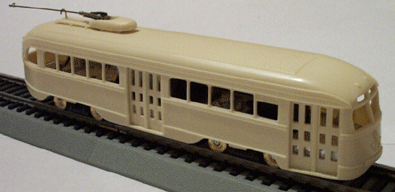
The generic air-car kit is currently $120.00 but there is a built-up version available at $225.00. This is the car that LARy/LATL/LAMTA P-1 modelers have been waiting for and it is priced right. Add some paint and a set of Custom Traxx CN-3100 decals and you have a great looking accurate model. San Diego also used these cars and Shoreline Decals makes a great set for those Custom Traxx has a destination decal set, CT-528 for these cars also.
IHP also upgraded their HO scale Kansas City PCC [87127], Pittsburgh 1700 series PCC [87128] and their Kawasaki Single End Light Rail Transit Vehicle LRT [87120] cars. Both the Kansas City and Pittsburgh cars have revised shells with greater detail and much more prototypically curved front and rear ends. Note the Kansas City PCC below:
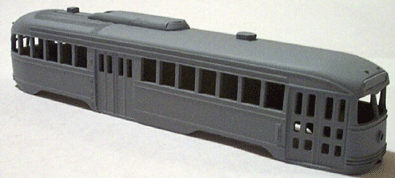
These wonderfully aesthetic cars also ran in Philadelphia, San Francisco, Tampico and Toronto) and several of the cars had their electrical gear sent to Belgium for installation in cars to run there. So you modelers of transit in those cities have another model to add to your collections. They are unpainted but the schemes are not difficult and Custom Traxx makes some fine decals for the Philadelphia, San Francisco and Toronto cars.
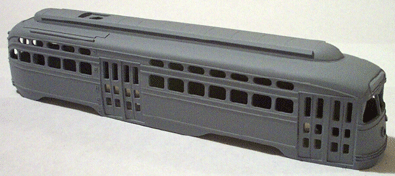
The [87128] Pittsburgh PCC is shown above and could be reworked into a SEPTA PCC-II if sufficient modeling skill is available. Both the Kansas City & Pittsburgh PCC shells are affordably priced at $43.00 and accept the Bowser 125141 mechanism. There are also built up but unpainted versions also available at $175.00. These units feature Bowser mechanisms and trolley poles. Kansas City cars eventually ran in Philadelphia, San Francisco, Tampico and Toronto.
The upgraded [87120] LRT has a more detailed shell with the LRT/LRV track brake assembly and a cast metal floor which accepts the Bowser 125100 mechanism. This car should be available by this summer, Ready-To-Run at $250.00. For more information on these and other IHP traction products, please visit their web site at www:ihphobby.tripod.com.
_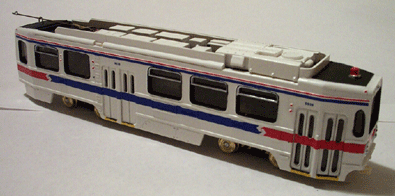
Of course, Trolleyville always recommends that users of Bowser traction drives install the A-line #20040 Bowser flywheel kit for better performance and to add required weight. Our initial tests showed the Air-Electric PCC to weigh 6.5 ounces so we will be adding the A-line flywheel and 2.0 oz of weight. The Kansas City PCC weighs only 4.6 ounces. so after the flywheel addition and 2.0 oz of additional weight, total weight will only be 7.1 oz. The weight issue is more critical is operating under operational overhead wire. We believe that the Bowser unit was designed with the weight of the Bowser shells in mind and that the closer you get to the one ounce per five scale feet of model the better will be the overall performance. So our goal for a normal PCC car is 9.0 ounces. We will be turning these two models into replicas of PTC 2508 and 2260, respectively. We will show them in a future issue. Nevertheless, HO scale trolley modelers have three more great but moderately priced trolley cars for their modeling pleasure!
Transquip, a major retail dealer and prototype PCC/Birney Safety Car consultant for Corgi, displayed a prototype of the next CORGI PCC in the series. This car would be the thirtieth in the series and would be car Philadelphia car 2101 in the SEPTA "Gulf Oil" paint scheme first introduced in 1973. By the way, car 2101 went on to become San Francisco 1062. You can see this car in Fisherman's Wharf on the Custom Traxx home page.
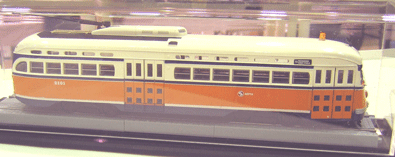
This paint scheme lasted until the final General Overhaul (GOH) cars evolved in 1979 with the remaining 110 cars getting the red-white-blue SEPTA colors.
In what was an interesting sight every time we passed this table, one vendor was selling a fleet of Boston Streetcar models, some of which were handcrafted brass. In the photo below, there are 36 streetcar models, including Boston Type 4, Type 5, CE motors and trailers, Commonwealth PCC, All-electric PCC and 1951 Picture Window PCC cars.

One of the cars came back to California with Custom Traxx. See more photos from this meet in Column 2.
_________________________________________________
Trolleyville
Examines the PCC-II
***
Last year, we had an opportunity to examine the PCC-II streetcar in Philadelphia. At that time, nine of the cars had been delivered and 2328 had just arrived. One year later, all 18 cars were delivered by November 2004 but service has yet to start on Route 15, Girard Avenue. We discuss the reasons for this in column II. See "Liars, Liars, Liars".
Regardless, there was a fan trip on the day after the East Penn Meet, which was sold out. It featured a two-car train of 1981 Kawasaki Light Rail Transit vehicles with a trip into the surface car subway. Shown below are LRT vehicles 9019 and 9009 in MU on Woodland Avenue.
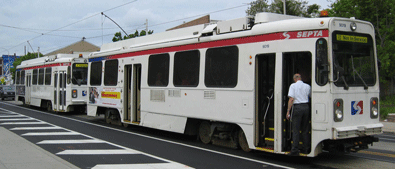
and then two of the PCC-II cars, 2335 and 2331. Shown below are the two cars on Chester Avenue
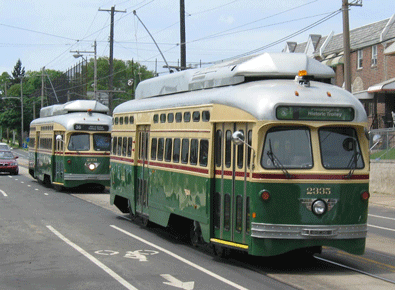
Portions of Route 10, 11, 13, 15,and 36 were covered along with non-revenue trackage. Although the Kawasaki vehicles are approaching 25 years of service, they do not look like it and they look a lot better than the PCC cars did around 1972 after SEPTA had control of them for a couple of years. They still ride fine and the riders that we talked to still feel that they are fine vehicles. But the new PCC-II cars ride better and smoother but only slightly. This is testimony to the engineering of the PCC-II but even greater testimony to the engineering and the team that designed and constructed the Kawasaki Light Rail Transit (LRT) vehicles 25 to 30 years ago. As fantastic as the PCC-II is, the Kawasaki LRT vehicle, at 25 years old, is unbelievable. Despite our less than complementary opinions of current senior SEPTA management, we must take note of the excellent employees who were on this trip with us. The two operators, called motormen in another age, were competent, courteous and enjoyable to be around. Operator Bill Monaghan was the lead operator on the two-car MU LRT train and the first of the PCC-II cars and Russell Greco was the second operator. Of course, Ed Springer, was the official SEPTA tour guide and leaves a great impression. Special note must be made about Bill Monaghan. All three employees showed the care for the equipment not normally seen by the average transit operator. They acted as if the car was their own personal vehicle, watching wheels and poles while passing special work. As far as they were concerned, there were not going to be any problems on this trip. Their job was not to just to complete this tour but to complete the tour RIGHT! The two operators reminded us of MUNI operator Harry Peat when he operated the only two-car train of Boeing SLRV's on San Francisco's Market Street many years ago. Russell displayed similar knowledge and professionalism while operating both the Kawasaki LRT and the PCC-II. It would be wonderful if senior SEPTA management were one tenth as professional and competent as these three employees.
The tour was great. The Kawasaki's are great and the PCC-IIs are great. These just may be among the finest items in Philadelphia.
_________________________________________________
MTS
Imports and Bowser-Stewart visited!
***
In conjunction with the East Penn Meet, Trolleyville took some time to visit MTS Imports, Inc, Middletown, NY and the Bowser-Stewart Company, Montoursville, PA to discuss their current and future traction projects.
MTS Imports, Inc began in 1972 as Model Traction Supply to make traction detail parts when Joel Lovitch, shown below in his crowded workshop, realized that there was no source of these items.
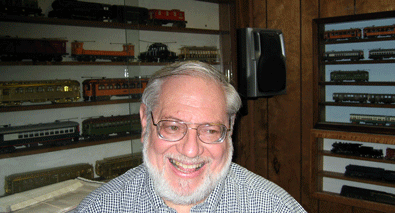
He started with a fare box and some controllers. The white metal kits began soon thereafter with a flat bed work motor, a differential dump car, a double cab flat work motor and the CTA 1-50 elevated car. By the mid-1970s, epoxy kits began with New York City subway cars, the Brooklyn Clark PCC. Joel is a determined businessman who is very much interested in modeling electric railways and takes great care to ensure that his models are reasonable representations of the prototype and that they run equally well.
[See Trolleyville Visits, Column 2]
Liars!
Liars!
Liars!
Silly Philly Continues!
(Trolleyville
Editorial)
***
Remember that really funny movie with Jim Carrey as the lawyer who could not tell a lie? The premise was enjoyable and seemed to work out in the end but when applied to the state of Philadelphia transit, it would have been great if the same thing happened.
Politics has not done anything for the improvement of transit systems (or anything else for that matter). If you don't believe us, get a copy of the Philadelphia Bulletin from the mid 1960's listing all the great things that SEPTA was going to do when they got control of the Philadelphia Transportation Company......Read that list of LIES!
All SEPTA did was prove that the old Philadelphia Transportation Company (PTC) knew how to run a sucessful transit system. PTC got out of the business before the know-it-all, but totally ignorant politicians and their well-paid sycophants would slowly but steadily ruin Philadelphia transit just as effectively as Los Angeles politicians ruined the Los Angeles Police department.
In the summer of 1992, the Southeastern Pennsylvania Transportation Authority, better known as SEPTA to Philadelphia and surrounding suburban residents, suddenly withdrew the last of the PCC cars from Routes 15, Girard Avenue; Route 23, Germantown Avenue and Route 56, Erie Avenue. Of course they had wanted to do this since the day they took control. Gone already were 6 of the 14 trolley routes that they inherited from the PTC; 6-Ogontz Avenue, 47-North 5th St, 50-Rising Sun Avenue, 53-Wayne Avenue, 60-Allegheny Avenue and 62-Darby-Yeadon. They claimed that the cars were too "worn out" for further use. Of course the years of neglect and lack of proven maintenance techniques had something to do with this. Of course, 13 of these same so designated "worn-out" cars have so far run almost another ten years in San Francisco to "crush" loads daily. [MORE LIES!]
They promised to get new trolleys for the three routes within five years. [MORE LIES!] After no action on this promise for over ten years, the City of Philadelphia forced the return of Route 15 to a heritage trolley line and 18 of the same "worn out" PCC cars were sent to Brookville and totally rebuilt. They were air-conditioned and made ADA compliant. These PCC-IIs are actually modern light rail vehicles in a heritage PCC body and were supposed to enter service in June 2004.
But that date was not met and Route 15 has yet to run due to a contrived dispute in the neighborhood of Callowhill Depot where the cars would be housed and there is no leadership present anywhere in the city to fix the problem.
Since that time, SEPTA has done everything politically possible to make that another LIE. The depot that housed routes 23 and 56 was abandoned and sold. Half of Route 56, Torresdale Avenue was paved over and the overhead wires were removed after no effort since 1992 was made by SEPTA to repair any of the decaying infrastructure that they promised to preserve. [AGAIN... LIES!]
As these PCC-II cars started to be delivered and the officials saw how marvelous the cars were, SEPTA hastened the deterioration of the remaining network. Almost all remaining PCC cars were dispositioned and recently two blocks of Route 23, held intact since 1992, were paved over (just the track area), making that route now unusable.
Government supported urban transit agencies currently seem to fall into two main categories. The first group tries to maintain transit as a primary goal and support the other political requirements such as bike paths and trails as a necessary evil but not detracting from the main purpose. Since some local governments tend to use the local transit entity as a source for funding welfare programs, this is a challenging job, at best. The second group is mainly concerned with obtaining as much money that they can accumulate from any source whatever and then doing as little as possible to maintain their source of funding. The comfort and convenience of their passengers means nothing. They have reduced their customer base, though constant mismanagement, to those who can't or won't drive cars. These people have no power so when a union strikes and shuts down the entire system, these organizations actually "make" money. SEPTA, in the opinion of the writer, is a classic example of the second group.
The major reason for the delay in the start of Route 15 operation is that SEPTA does not really want to run trolley cars or rail lines for that matter, despite how really comfortable, useful and pleasant that they may be. There is and has been for some time, a strong anti-rail culture within senior SEPTA management. The transit agency was really "forced" by exterior influence into returning rail to Route 15 as they had promised but never really wanted or intended to do. They have resented this move and have demonstrated this every time that there was such as opportunity. But there is a fly in the ointment. As reported elsewhere in this issue, these are really fine, comfortable cars with excellent brakes, acceleration and comfort. Had SEPTA really wanted this line to operate, it would have began operation long before this. This is another case of a so-called transit agency not acting in the best interests of its customers. But, the way things are today, they do not have to!
Meanwhile, the riders of and the residents along the former trolley routes 23 and 56 will be cheated out of these new smooth, quiet vehicles as SEPTA realizes that the patrons will like these new cars and will want them on the other routes. So both routes and the cars that would have run on them have been made to systematically disappear.
What would have been intelligent would have been for the current surrogate, excuse for leadership to promote the line and the new vehicles and encourage some development along the line, as other enlightened cities are doing. Tourists bring needed dollars to a city and cities need dollars. But not here, parking vehicles is the top priority!
Guess what! San Francisco is now the trolley car capital of the North American continent now largely due to to the stupidity of certain SEPTA officials and the apathy and maybe corruption of local city officials. These trolleys, the majority of which used to neglectfully run in Philadelphia are bringing riders and money to the transit system. These riders are largely local customers not the tourists that the line was intended to serve. The residents of 59th Street may have preserved their precious parking spaces but they will never know how costly those spaces were. They could have all have been furnished with new BMW sedans with just a portion of the money that they and their really stupid councilman have cost the future coffers of the City of Philadelphia. This city is not even a bad joke second prize any longer!
On Tuesday, May 10th, San Francisco took delivery of it's first ex-Newark PCC cars. The car, 1080, is adorned in the Los Angeles Transit Lines "Fruit Salad" livery. This car is shown below at Geneva Car House sandwiched between original MUNI car 1010 and 1060, another former SEPTA PCC found unworthy of use in the City of Brotherly Love. Meanwhile, back in Philadelphia on Memorial Day, the enlightened 59th street residents showed their "best" side to the riders of a chartered PCC-II. More out-of-town people were shown why Philadelphia continues to be a late night talk show joke despite all the good things in that city.
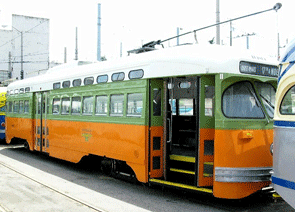
So more East Coast treasures will become a tourist attraction in the City By the Bay. The most popular trolley line in America is mainly made up of ex-Philadelphia cars, ex-Newark cars and ex-Milan, Italy cars whose design was copied from a former class of Philadelphia streetcars. Oh yes, SEPTA had one operational survivor of this 1923-1926 class of streetcars at their Elmwood Depot, but it was in the way. They threatened to scrap it in 2004 so it had to go too! It is bad enough that these people are such liars but, even worse, they are....
Stupid!
Stupid!
Stupid!
_____________________________
[Trolleyville Visits, from Column 1]
MTS Imports, Inc emerged when brass model importing began with the Brill 14-bench open car. Up to this point, 110 different brass models, including variations, in both HO and O scale have been imported. When Joel was asked about the future models, the conversation became much more detailed and ended with a projection of the future of brass traction models. As of today, the CTA "Baldy" elevated car and the Connecticut 15-bench open car are the next to be imported. There are no commitments further. But the CTA car will not be here before the end of 2005, if that soon. In discussing the future, several points were discussed. Joel was the first to point out that the number of traction enthusiasts is diminishing as the general model railroading population ages and the increasing cost of labor to fabricate brass models had gotten very high. When brass traction models were introduced in the 1950's, this was the only way at the time to achieve finely detailed models. With the low labor rate then in Japan, the marriage was ideal. At the current time, molding techniques have drastically improved along with some very adaptable molding materials. Couple these innovations with three dimensional CAD programs and today's plastic model trains match and even exceed the detail found on the brass imports. With stereo lithography on the horizon, it is anyone's guess what the future will bring to the plastic model arena. Stereo Lithography is the process of creating a first article from photo sensitive resin using a three-dimensional CAD program. Trolleyville watched this process produce very finely detailed objects within the last three years during visits to several plants in the Southern California area. It is very impressive.
One last point, MTS Imports, Inc is a business. They will produce brass models to which modelers indicate that they will purchase. This means that sufficient modelers have "put their money where their mouth is". If you really want to have one of the 108" wide PCC cars or the PERy 1601 class steeple cab models and you have NOT reserved one of the models, YOU are part of the reason that the models have not been made yet!
The visit to the new Bowser-Stewart plant was equally informative. Bowser Manufacturing purchased the entire Stewart operation last year and moved the entire operation to the Montoursville facility. Lee English now runs the entire operation and has taken many steps to streamline business operations and cut unneeded steps while improving plant output. Trolleyville received a complete plant tour and found it to be an efficient operation with competent, happy employees. A family atmosphere seems to exist throughout the plant.
During the visit, several modifications were suggested to the 125141 and 125147 mechanisms. In the 125147, it wa suggested that the front of the floor be modified so that a headlight can be added without interfering with the floor. The 125147 would allow the use of A-Line and other precision motors if some material between the motor mounts were removed. Also the use of a spring to improve tracking of the unpowered center truck was suggested. All these modifications were placed under study for incorporation. No visit to Bowser is complete without a trip to Northumberland to see where molds are made and a lunch stop at the Village Ice Cream and Restaurant. Great Food and open every day for great eating!
__________________________________________
More East Penn Traction Club Meet Photos!
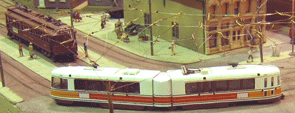 Above
is Custom Traxx MUNI car 1220
passing a Pacific Electric Interurban
on one group of East Penn Traction
Club HO scale modules.
Above
is Custom Traxx MUNI car 1220
passing a Pacific Electric Interurban
on one group of East Penn Traction
Club HO scale modules.
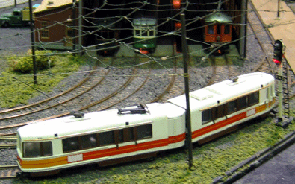
Above is another Custom Traxx San Francisco SLRV, Muni 1213 on another group of East Penn Traction Club HO scale modules. Both SLRVs were equipped with the new 125147 Bowser floor and drive and they performed flawlessly for hours.
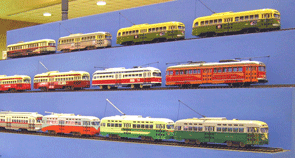
Above are some of the Saint Petersburg Trams available for purchase at the meet. These included model PCC cars from Chicago, Philadelphia, Toronto, San Francisco, Pacific Electric, Newark, and Washington D.C.
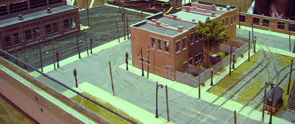
Above is a fine module shown by KND at the meet. the overhead wire was extremely well detailed but still very operational.
Suggest that all who were not at the 2005 meet make sure they attend the 2007 meet! They really missed a good one this year!